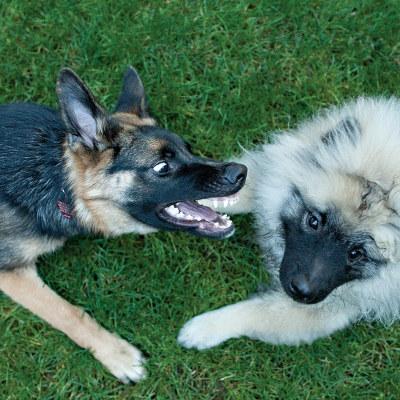By Natalie Lester, Brand Marketing Specialist
In this picture, Emma is engaging in object play with her rope. What type of play below does your dog like best?
 One of my favorite things about my Boykin Spaniel puppy, Emma, (and any other dog for that matter) are their constant playful attitudes. Nothing brings my heart as much joy as watching Emma hop across the grass chasing one of her playmates.
One of my favorite things about my Boykin Spaniel puppy, Emma, (and any other dog for that matter) are their constant playful attitudes. Nothing brings my heart as much joy as watching Emma hop across the grass chasing one of her playmates.
Lately, her office favorites include Buckley (who tells Emma she is really looking forward to being in her Mom’s wedding) and another new puppy at the office, the Golden Retriever Mitch.
If I could let her, I would let them play all day. But, I have to get some work done. There have been more than a couple times where Emma has had to sit on my lap during a meeting because she couldn’t resist the temptation to bark or chase her fellow dog associates around the table, and I was starting to wonder what classified as good play behavior and bad play behavior.
Then, Dr. Julie Albright from the University of Tennessee’s College of Veterinary Medicine visited our office to give a lesson on just that subject! What a relief! Dr. Albright also serves as the PetSafe Chair in Small Animal Behavioral Research.
She and her team have been observing and researching play among dogs for a lot longer than my two months of puppy ownership, so her advice was really insightful. Here is a quick recap of what I learned.
Natalie and Emma LOVE to play tug-a-war together. What do you and your pets play?
Movement or interaction which does not contribute to survival, appears spontaneous and rewarding, and differs from serious behavior may be qualified as play.
It is fairly common in animals, especially those who are highly social like primates, predators, and birds. Dr. Albright and her team are not clear on the functionality, or the reason, animals play.
She speculated it could be to build motor coordination, strength, or connections between the nervous system and muscles. Or, it could be preparation for the unexpected or assessment about the animals around them.
We also know that winning is fun, and dogs LOVE fun.
There are four types of play:
1. Social: Play fighting and wrestling (Right now, this is Emma’s favorite!)
2. Object play: Interaction with toys, treats, etc. (Emma loves her Bouncy Bone lately!)
3. Locomotor: Moving from one place to another (Wait, Emma really loves to run, too.)
4. Combined: Mixing two of the above types (She loves to chase other dogs, roll wrestle with them, and play tug-a-way with the Slap Happy.)
In the end, I decided Emma was fit for all types of play. Dr. Albright also taught us to look for the signs of healthy and unhealthy play in our pets to know who is best to interact with and keep our pets safe.
Healthy play includes pauses, exaggerated and lateral movements, open mouth, low tails, play bows, and emotional control.
Unhealthy behavior misses many of these movements with increasing arousal, changes in vocalization, and one dog attempting to terminate play. The best way to handle the unhealthy behavior is to prevent it before it gets out of hand.
If you start to notice your puppy is increasing with emotions or arousal, remove them from the environment and playmate.
What is your favorite thing your dog does during play? Come back on Friday for a post about using play as a training tool!
ABOUT NATALIE As the PetSafe Brand Marketing Specialist, Natalie manages The Paw Print blog and generates other brand related content including public relations and promotions. Before PetSafe, Natalie worked in the local media covering politics, education, and religion. Natalie’s puppy, Emma, spends almost as much time in the office as she does.



